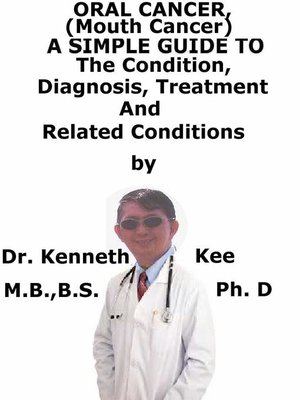Oral Cancer, (Mouth Cancer) a Simple Guide to the Condition, Diagnosis, Treatment and Related Conditions
ebook
By Kenneth Kee

Sign up to save your library
With an OverDrive account, you can save your favorite libraries for at-a-glance information about availability. Find out more about OverDrive accounts.
Find this title in Libby, the library reading app by OverDrive.



Search for a digital library with this title
Title found at these libraries:
| Library Name | Distance |
|---|---|
| Loading... |
Oral cancer is cancer that affects any part of the mouth, including the tongue and lips.The most frequent symptoms are having a sore or ulcer for more than three weeks.Mouth cancer can begin anywhere in the oral cavity:1. Lips2. Inside lining of the cheeks and lips (buccal mucosa)3. Front 2/3 of the tongue4. Gums (gingiva)5. Floor of the mouth6. Roof of the mouth (hard palate)7. Area behind the wisdom teeth (retro-molar trigone)The mouth and oro-pharynx help a person breathe, talk, eat, chew and swallow.Cancer beginning in this area is called oro-phayngeal cancer.The oro-pharynx is the:1. Back 1/3 of the tongue2. Soft area at the back of the roof of the mouth (soft palate)3. Tonsils and 2 ridges of tissue in front of and behind the tonsils (tonsillar pillars)4. Back wall of the throatCancers starting in the mouth and oro-pharynx can extend to the lymph nodes in the neck because they are close by.Some people with mouth or oro-pharyngeal cancer often have a surgery to eradicate lymph nodes from the same side of the neck as the cancer.Occasionally the surgeon might remove them on both sides.Most oral cancers are a form called squamous cell carcinoma.These cancers are likely to spread quickly.1.Smoking and other tobacco usage are linked to most patients of oral cancer.2.Heavy alcohol use also raises the risk for oral cancer.3.Chewing betel nut (gutkha) is well-known to cause mouth and oro-pharyngeal cancer.4. A poor diet may raise the danger of some forms of mouth and oro-pharyngeal cancer.5.Human papilloma virus is a sexually transmitted disorder.Only a very small percentage of people with HPV form mouth or oro-pharyngeal cancer.The danger of HPV infection in the mouth and throat is linked to some sexual behaviors, such as oral sex and having a greater number of sexual partners.6.Chronic infection from ill fitting dentures7.Weak immune system8.Abnormal patches in the moutha. The red patches are called erythroplakia.b. White patches are called leukoplakiaSymptoms1.Mouth ulcers that do not heal2.Pain in the mouth3.White or red patches in the mouth4.Difficulty in swallowing5.Speech disorders6.A lump in the neckDiagnosisTests used to confirm oral cancer are:1. Gum biopsy2. Tongue biopsy3. X-rays and CT, MRI and PET scansTreatment:Many patients are diagnosed at an early stage because early mouth cancers are more easily noticed.There is a good likelihood of a cure if it is treated in the early stages.Surgery to remove the tumor is normally advised if the tumor is small enough.Surgery may be combined together with radiation therapy and chemotherapy for larger tumors.Dependent on the form of treatment the patient needs, support treatments that may be required are:1. Speech therapya. Therapy to help with chewing, swallowingb. Learning to eat enough protein and calories to keep the weight upc. Ask the doctor about liquid food supplements that can helpBiological therapy is treatment that stop or slow the growth of cancer or destroy cancer cells.Reconstruction is important in mouth surgery in order to ensure a functional and cosmetic outcomeEven after completing treatment of mouth cancer , patients have to undergo months of rehabilitation to recover speech and swallowing problems following the surgery or treatment.Speech and swallowing therapy and proper diet with a dietician are important.TABLE OF CONTENTIntroductionChapter 1 Oral CancerChapter 2 CausesChapter 3 SymptomsChapter 4 DiagnosisChapter 5 TreatmentChapter 6 PrognosisChapter 7 Salivary Gland CancerChapter 8 Tongue CancerEpilogue







